道康宁737胶水
- 格式:doc
- 大小:26.00 KB
- 文档页数:1
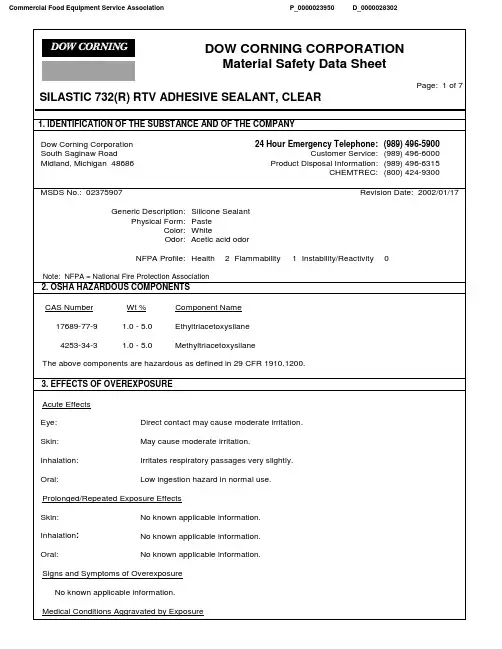


道康宁DOW CORNING 737硅胶/密封胶描述:多用途硅密封胶,广泛应用于工业装配与安装。
应用:UL94HB认证,通用型,接着性好。
北京瑞德佑业王雅蓉 TEI:OIO-6253897I特性:1、不流动膏状;2、可粘结大多数塑料、金属、油漆表面、玻璃和橡胶等材料;3、快速固化.3~6分钟表面固化,24小时内完全固化;4、不会与大多数金属或塑料发生化学反应或腐蚀作用;5、100%硅橡胶UL工作温度:-65℃到+177℃用途道康宁®737中性固化密封胶是专为OEM和多样集会的申请。
一般用途包括粘接,密封,形成,内置式垫圈和维护应用。
具体用途包括:•替代为大型和小型电器机械紧固件•密封冰箱和冰柜内衬(但是,不是FDA的批准食品接触应用)•坚持为装饰应用,贴花塑料基板塑料模具•防水电器元件•密封同轴连接器•保护仪器组件公司专业销售各类工业辅料,经营品牌:3M胶带,3M胶水,3M电工电子产品,3M劳动防护,汉高胶粘剂,乐泰胶水,道康宁硅胶,摩力克 molykote润滑剂,ITW,DEVCON修补剂,LPS清洗剂,LORD结构胶,CHEMLOK橡胶底涂胶,DYMAX UV 光固化胶,信越硅胶,迈图硅胶,爱玛森康明电子胶,爱劳达灌封胶,Ablestik 爱波斯迪科, Emerson&cuming 爱玛森康明, Acheson油墨, humiseal三防漆,CRC 清洗剂\润滑剂,日本三键胶水,施敏打硬胶水,昭日化学,MAXBOND黄胶,金佰利擦拭纸,NOMAX绝缘纸,柯图泰PET膜,GE PC膜等多种工业辅助材料. 应用包括塑料粘接,PP粘接,PE粘接,PC粘接,PVC粘接,PU粘接,尼龙粘接,有机玻璃粘接,PMMA粘接,POM粘接,PBT粘接,PET粘接,聚甲荃粘接,聚砜粘接,聚丙稀粘接,聚乙稀粘接,聚碳酸酯粘接,聚酰亚胺粘接,聚苯乙稀粘接,ABS粘接,四氟乙稀粘接,PU粘接,聚氨酯粘接,TPU粘接。
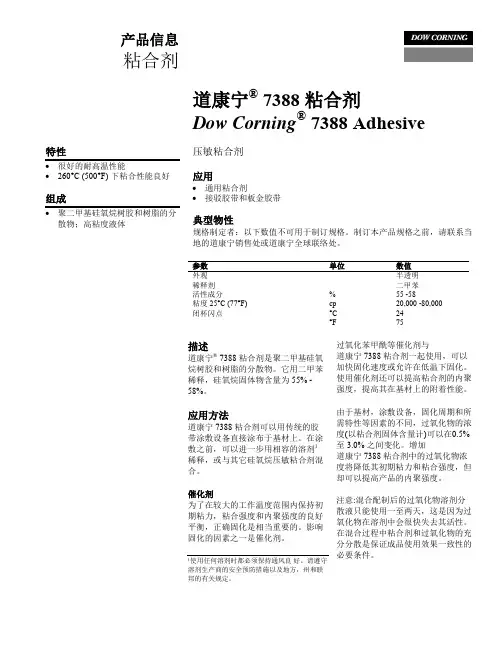
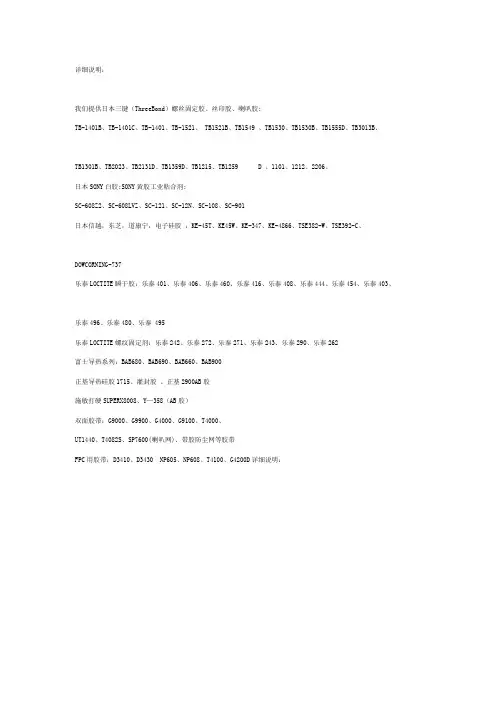
详细说明:我们提供日本三键(ThreeBond)螺丝固定胶、丝印胶、喇叭胶:TB-1401B、TB-1401C、TB-1401、TB-1521、 TB1521B、TB1549 、TB1530、TB1530B、TB1555D、TB3013B、TB1301B、TB2023、TB2131D、TB1359D、TB1215、TB1259 D 、1101、1212、2206、日本SONY白胶;SONY黄胶工业粘合剂:SC-608Z2、SC-608LVZ、SC-121、SC-12N、SC-108、SC-901日本信越,东芝,道康宁,电子硅胶:KE-45T、KE45W、KE-347、KE-4866、TSE382-W、TSE392-C、DOWCORNING-737乐泰LOCTITE瞬干胶:乐泰401、乐泰406、乐泰460、乐泰416、乐泰408、乐泰444、乐泰454、乐泰403、乐泰496、乐泰480、乐泰 495乐泰LOCTITE螺纹固定剂:乐泰242、乐泰272、乐泰271、乐泰243、乐泰290、乐泰262富士导热系列:BAB680、BAB690、BAB660、BAB900正基导热硅胶1715、灌封胶、正基2900AB胶施敏打硬SUPERX8008、Y—358(AB胶)双面胶带:G9000、G9900、G4000、G9100、T4000、UT1440、T4082S、SP7600(喇叭网)、带胶防尘网等胶带FPC用胶带:D3410、D3430 NP605、NP608、T4100、G4200D详细说明:紫外线固化技术(简称 UV 技术),被认为是一种环境友好的绿色技术,亦称 3E 技术,即节能( energy )、环保( environment )、经济( economy ),主要应用于涂料、油墨、胶粘剂等领域。
其中 UV 胶广泛应用于玻璃制品与珠宝业、玻璃家具、医疗器具、电子、电器、光电子、光学仪器、制造等领域,如电子线路板、电子元器件、数码相机、电子称制造、蜂鸣片等产品的制造。

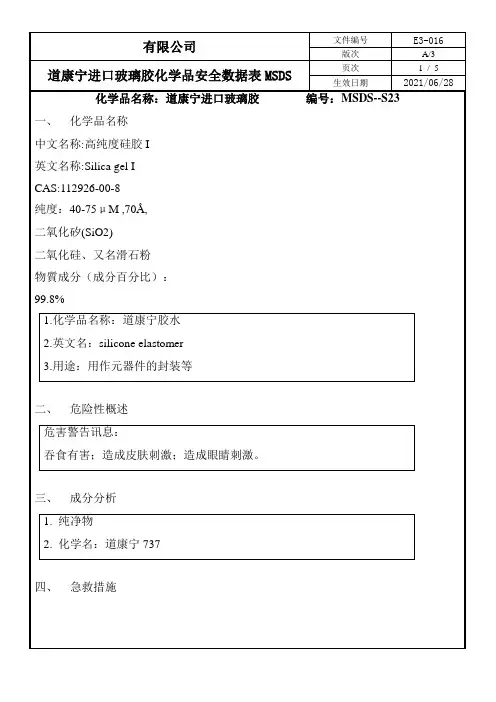
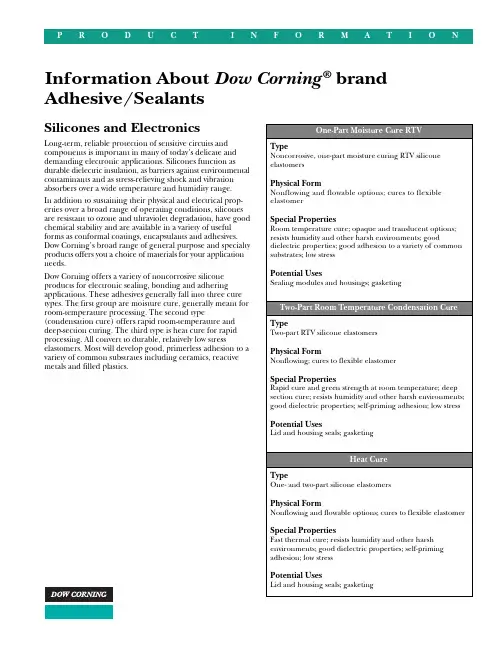
Information About Dow Corning ® brand Adhesive/SealantsSilicones and ElectronicsLong-term, reliable protection of sensitive circuits and components is important in many of today’s delicate and demanding electronic applications. Silicones function as durable dielectric insulation, as barriers against environmental contaminants and as stress-relieving shock and vibration absorbers over a wide temperature and humidity range.In addition to sustaining their physical and electrical prop-erties over a broad range of operating conditions, silicones are resistant to ozone and ultraviolet degradation, have good chemical stability and are available in a variety of useful forms as conformal coatings, encapsulants and adhesives.Dow Corning’s broad range of general purpose and specialty products offers you a choice of materials for your application needs.Dow Corning offers a variety of noncorrosive silicone products for electronic sealing, bonding and adhering applications. These adhesives generally fall into three cure types. The first group are moisture cure, generally meant for room-temperature processing. The second type(condensation cure) offers rapid room-temperature and deep-section curing. The third type is heat cure for rapid processing. All convert to durable, relatively low stresselastomers. Most will develop good, primerless adhesion to a variety of common substrates including ceramics, reactive metals and filled plastics.TYPICAL PROPERTIESThese values are not intended for use in preparing specifications.Specification Writers: Please obtain copies of the Dow Corning Sales Specifications for these products and use them as a basis for your specifications. They may be obtained from any Dow Corning Sales Office, or from Dow Corning Customer Service in Midland,MI. Call (517) 496-6000.HEAT CURE TIMESCURE CONDITIONSOne-Part Moisture Cure RTVThe one-part moisture cure adhesives (838, 839, 3165, 3145,3140 and 3-1744) are generally cured at room temperature and in a range of 30 to 80 percent relative humidity. Greater than 90 percent of their full physical properties should be attained within 24 to 72 hours depending on the product chosen. Materials and parts can be handled in much shorter times of about 10 to 120 minutes depending on the product chosen and the amount of material used per part. These materials are not typically used for highly confined or deep section cures. Materials will generally cure about 0.25 inch per seven days from any exposed surface. Cure progresses from the outer surface and is dependent on the moisture in the air. Working time is generally a few minutes to an hour for these products until a surface skin begins to form. Mild heat acceleration of the cure rate may be possible but temperatures above 60°C (140°F) are not recommended.Two-Part Room Temperature Condensation CureDow Corning ® Q3-6093 Silicone Adhesive is the only two-part condensation curing product. Once mixed, cure progresses rapidly at room temperature. Good strength is attained within an hour but full properties are not reached for anumber of days. Q3-6093 adhesive contains its own source of moisture and cure progresses evenly throughout the material.Deep section or confined cures are possible however (see “Reversion”). Working time is only a few minutes.Heat CureThe addition curing adhesives (577, 3-6876, 3-6611 and 3-6265) should be cured at 100°C (212°F) or above. The cure rate is rapidly accelerated with heat (see cure schedulesin table). For thicker sections or if voiding is observed, a 30 minutes pre-cure at 70°C (158°F) may reduce voids in the elastomer. Addition-curing materials contain all the ingredients needed for cure with no byproducts from the cure mechanism. Deep section or confined cures arepossible. Cure progresses evenly throughout the material.These adhesives generally have long working times.PREPARING SURFACESAll surfaces should be thoroughly cleaned and/or degreased with Dow Corning ®brand OS Fluids, naphtha, mineral spirits,methyl ethyl ketone (MEK) or other suitable solvent.Solvents such as acetone or isopropyl alcohol (IPA) do not tend to remove oils well, and any oils remaining on the surface may interfere with adhesion. Light surface abrasion is recommended whenever possible, because it promotes good cleaning and increases the surface area for bonding. A final surface wipe with acetone or IPA is also useful.Different cleaning techniques may give better results than others. Users should determine the best techniques for their applications.ADHESIONDow Corning silicone adhesives are specially formulated to provide unprimed adhesion to many reactive metals,ceramics and glass, as well as to selected laminates, resins and plastics. However, good adhesion cannot be expected on nonreactive metal substrates or non-reactive plastic surfaces such as Teflon ®, polyethylene or polypropylene. Special surface treatments such as chemical etching or plasma treatment can sometimes provide a reactive surface and promote adhesion to these types of substrates. Dow Corning ®brand primers (see “Primer Selection Guide”) can be used to increase the chemical activity on difficult substrates.2P5200 Red is a low-VOC alternative to 1200 Red.3P5204 is a low-VOC alternative to 1204.4The lower VOC value is for states and air quality management districts that have recognized volatile methylsiloxanes as VOC exempt.PRIMER SELECTION GUIDEThese values are not intended for use in preparing specifications.Poor adhesion may be experienced on plastic or rubber substrates that are highly plasticized, because the mobile plasticizers act as release agents. Small-scale laboratory evaluation of all substrates is recommended before production trials are made.In general, increasing the cure temperature and/or cure time will improve the ultimate adhesion.SUBSTRATE TESTINGDue to the wide variety of substrate types and differences in substrate surface conditions, general statements on adhesion and bond strength are impossible. To ensure maximum bond strength on a particular substrate, 100 percent cohesive failure of the adhesive in a lap shear or similar adhesive strength test is desired. This ensures compatibility of the adhesive with the substrate being considered. Also,this test can be used to determine minimum cure time or can detect the presence of surface contaminants such as mold release agents, oils, greases and oxide films.USEFUL TEMPERATURE RANGESFor most uses, silicone elastomers should be operational over a temperature range of -45 to 200°C (-49 to 392°F) for long periods of time. However, at both the low and high temperature ends of the spectrum, behavior of the materials and performance in particular applications can become more complex and require additional considerations.For low-temperature performance, thermal cycling to conditions such as -55°C (-67°F) may be possible, butperformance should be verified for your parts or assemblies.Factors that may influence performance are configuration and stress sensitivity of components, cooling rates and hold times, and prior temperature history.At the high-temperture end, the durability of the cured silicone elastomer is time and temperature dependent. As expected, the higher the temperature, the shorter the time the material will remain useable.COMPATIBILITYCertain materials, chemicals, curing agents and plasticizers can inhibit the cure of addition cure adhesives. Most notable of these include:•Organotin and other organometallic compounds •Silicone rubber containing organotin catalyst •Sulfur, polysulfides, polysulfones or other sulfur-containing materials•Amines, urethanes or amine-containing materials •Unsaturated hydrocarbon plasticizers •Some solder flux residuesIf a substrate or material is questionable with respect to potentially causing inhibition of cure, it is recommended that a small scale compatibility test be run to ascertain suitability in a given application. The presence of liquid or uncured product at the interface between the questionable substrate and the cured gel indicates incompatibility and inhibition of cure.MIXING AND DE-AIRINGUpon standing, some filler may settle to the bottom of the liquid containers after several weeks. To ensure a uniform product mix, the material in each container should be thoroughly mixed prior to use.1Clear only.2Gray only.3UL746C Approved.LISTINGS AND SPECIFICATIONSDow Corning Corporation Midland, Michigan 48686-0994Dow Corning and Sylgard are registered trademarks of Dow Corning Corporation.Teflon is a registered trademark of E.I. du Pont de Nemours Co.©2000 Dow Corning Corporation. All rights reser ved.Printed in USAAGP4781Form No. 10-911A-01Two-part materials should be mixed in the proper ratio (1:1or 10:1) either by weight or volume. The presence of light colored streaks or marbling indicates inadequate mixing.Automated airless dispense equipment can be used toreduce or avoid the need to de-air. If de-airing is required to reduce voids in the cured elastomer, consider a vacuum de-air schedule of >28 inches Hg for 10 minutes or until bubbling subsides.REVERSIONWhen two-part condensation curing materials with organo-tin catalysts, such as Q3-6093 adhesive, are cured in confinement (especially in deep section) and are later subjected to high heat conditions, can potentially revert back from a cured elastomer to a flowable polymer.Although this condition is unusual, parts using Q3-6093adhesive should be thoroughly tested in accelerated temperature conditions for this potential limitation.SOLVENT EXPOSUREWhen liquid or vapor solvent or fuel exposure can occur in an application, the silicone adhesives discussed in thisbrochure are intended only to survive splash or intermittent exposures. They are not suited for continuous solvent or fuel exposure. Testing should be done to confirm performance of the adhesives under these conditions.STORAGE AND SHELF LIFEShelf life is indicated by the “Use Before” date found on the product label.For best results, Dow Corning RTV adhesives should be stored at or below 25°C (77°F). Special precautions must be taken to prevent moisture from contacting these materials.Containers should be kept tightly closed and head or air space minimized. Partially filled containers should be purged with dry air or other gases, such as nitrogen.Dow Corning heat-cure adhesives should also be stored at or below 25°C (77°C). Containers should be kept tightly closed and kept in cold storage at all times to extend shelf life.LIMITATIONSThese products are neither tested nor represented as suitable for medical or pharmaceutical uses.PACKAGINGIn general, Dow Corning adhesives/sealants are supplied in nominal 0.45-, 3.6-, 18- and 200-kg (1-, 8-, 40- and 440-lb)containers,net weight. Not all products may be available in all packages and some additional packages, such as a bladder packs or tubes, may be available for certain coatings and package sizes.SAFE HANDLING INFORMATIONPRODUCT SAFETY INFORMATION REQUIRED FOR SAFE USE IS NOT INCLUDED. BEFORE HANDLING,READ PRODUCT AND MATERIAL SAFETY DATA SHEETS AND CONTAINER LABELS FOR SAFE USE, PHYSICAL AND HEALTH HAZARD INFORMATION. THE MATERIAL SAFETY DATA SHEET IS AVAILABLE FROM YOURDOW CORNING REPRESENTATIVE, OR DISTRIBUTOR,OR BY WRITING TO DOW CORNING CUSTOMER SERVICE, OR BY CALLING (517) 496-6000.WARRANTY INFORMATION – PLEASE READ CAREFULLYThe information contained herein is offered in good faith and is believed to be accurate. However, because conditions and methods of use of our products are beyond our control,this information should not be used in substitution for customer’s tests to ensure that Dow Corning’s products are safe, effective, and fully satisfactory for the intended end use. Dow Corning’s sole warranty is that the product will meet the Dow Corning sales specifications in effect at the time of shipment. Your exclusive remedy for breach of such warranty is limited to refund of purchase price or replace-ment of any product shown to be other than as warranted.Dow Corning specifically disclaims any other express or implied warranty of fitness for a particular purpose or merch-antability. Unless Dow Corning provides you with a specific,duly signed endorsement of fitness for use, Dow Corning disclaims liability for any incidental or consequential damages.Suggestions of uses should not be taken as inducements to infringe any particular patent.。
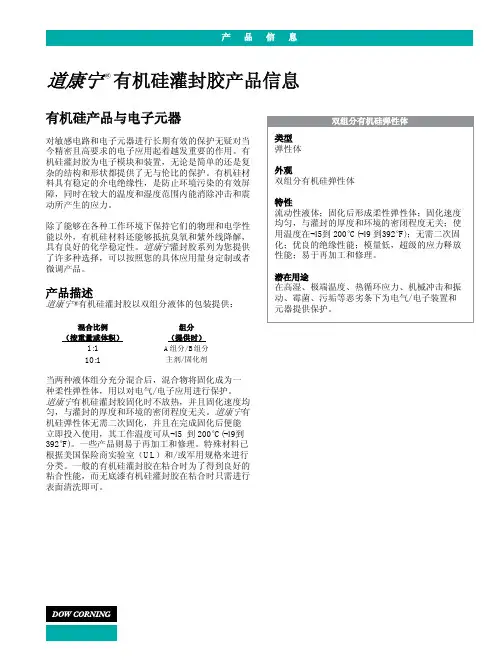
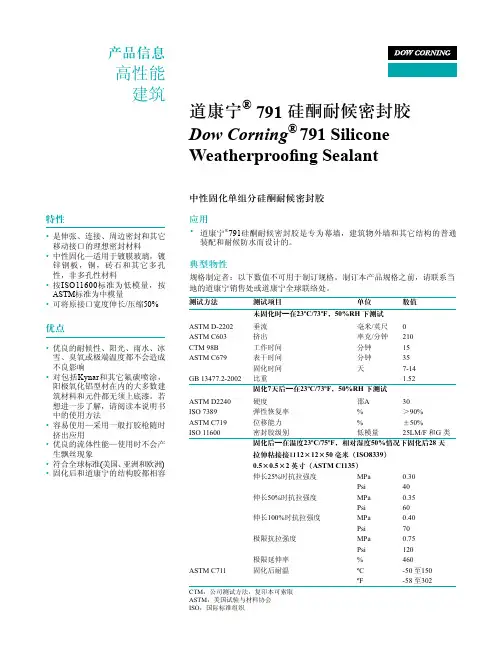
高性能建筑产品信息道康宁®791 硅酮耐候密封胶Dow Corning ®791 Silicone Weatherproo fing Sealant• 优良的耐候性、阳光、雨水、冰雪、臭氧或极端温度都不会造成不良影响对包括Kynar 和其它氟碳喷涂,阳极氧化铝型材在内的大多数建筑材料和元件都无须上底漆。
若想进一步了解,请阅读本说明书中的使用方法容易使用—采用一般打胶枪随时挤出应用优良的流体性能—使用时不会产生飘丝现象符合全球标准(美国、亚洲和欧洲)固化后和道康宁的结构胶都相容是伸张、连接、周边密封和其它移动接口的理想密封材料中性固化—适用于镀膜玻璃,镀锌钢板,铜,砖石和其它多孔性,非多孔性材料按ISO11600标准为低模量,按ASTM 标准为中模量可将原接口宽度伸长/压缩50%••• • • • • • • • 中性固化单组分硅酮耐候密封胶道康宁®791硅酮耐候密封胶是专为幕墙,建筑物外墙和其它结构的普通装配和耐候防水而设计的。
规格制定者:以下数值不可用于制订规格。
制订本产品规格之前,请联系当地的道康宁销售处或道康宁全球联络处。
应用典型物性特性优点测试方法 测试项目单位数值未固化时—在23ºC/73ºF ,50%RH 下测试 ASTM D-2202 垂流 毫米/英尺 0 ASTM C603 挤出 率克/分钟 210 CTM 98B 工作时间 分钟 15 ASTM C679 表干时间 分钟 35固化时间 天 7-14 GB 13477.2-2002 比重1.52固化7天后—在23ºC/73ºF ,50%RH 下测试ASTM D2240 硬度 邵A 30 ISO 7389 弹性恢复率 % >90% ASTM C719 位移能力 % ±50% ISO 11600 密封胶级别 低模量 25LM/F 和G 类 固化后—在温度23ºC/75ºF ,相对湿度50%情况下固化后28 天 拉伸粘接接口12×12×50 毫米(ISO8339)0.5×0.5×2 英寸(ASTM C1135)伸长25%时抗拉强度 MPa 0.30 Psi 40 伸长50%时抗拉强度 MPa 0.35 Psi 60 伸长100%时抗拉强度 MPa 0.40 Psi 70 极限抗拉强度 MPa 0.75 Psi 120 极限延伸率 % 460ASTM C711 固化后耐温 ºC -50 至150 ºF-58 至302产品说明道康宁791硅酮耐候密封胶是一种单组分,中性固化,建筑级密封胶,在任何温度下都能轻易地挤出使用,并能在室温下,借助于空气中的水份,与之反应并固化形成耐候,有弹性的硅酮密封胶。
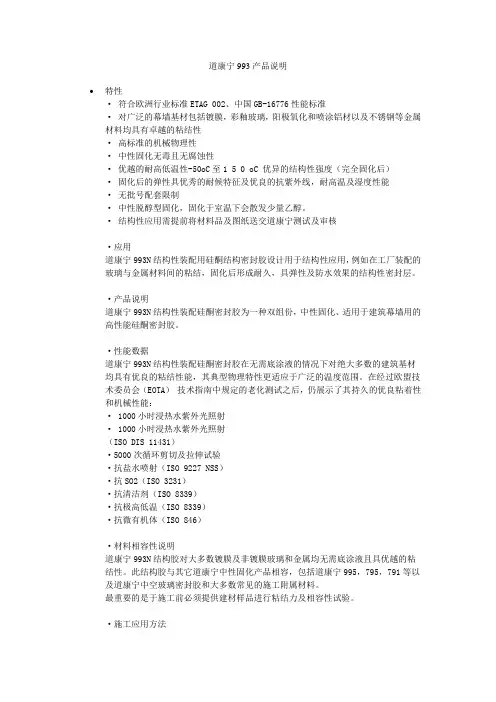
道康宁993产品说明特性· 符合欧洲行业标准ETAG 002、中国GB-16776性能标准· 对广泛的幕墙基材包括镀膜,彩釉玻璃,阳极氧化和喷涂铝材以及不锈钢等金属材料均具有卓越的粘结性· 高标准的机械物理性· 中性固化无毒且无腐蚀性· 优越的耐高低温性-50oC至1 5 0 oC 优异的结构性强度(完全固化后)· 固化后的弹性具优秀的耐候特征及优良的抗紫外线,耐高温及湿度性能· 无批号配套限制· 中性脱醇型固化,固化于室温下会散发少量乙醇。
· 结构性应用需提前将材料品及图纸送交道康宁测试及审核·应用道康宁993N结构性装配用硅酮结构密封胶设计用于结构性应用,例如在工厂装配的玻璃与金属材料间的粘结,固化后形成耐久,具弹性及防水效果的结构性密封层。
·产品说明道康宁993N结构性装配硅酮密封胶为一种双组份,中性固化、适用于建筑幕墙用的高性能硅酮密封胶。
·性能数据道康宁993N结构性装配硅酮密封胶在无需底涂液的情况下对绝大多数的建筑基材均具有优良的粘结性能,其典型物理特性更适应于广泛的温度范围。
在经过欧盟技术委员会(EOTA)技术指南中规定的老化测试之后,仍展示了其持久的优良粘着性和机械性能:· 1000小时浸热水紫外光照射· 1000小时浸热水紫外光照射(ISO DIS 11431)·5000次循环剪切及拉伸试验·抗盐水喷射(ISO 9227 NSS)·抗SO2(ISO 3231)·抗清洁剂(ISO 8339)·抗极高低温(ISO 8339)·抗微有机体(ISO 846)·材料相容性说明道康宁993N结构胶对大多数镀膜及非镀膜玻璃和金属均无需底涂液且具优越的粘结性。
此结构胶与其它道康宁中性固化产品相容,包括道康宁995,795,791等以及道康宁中空玻璃密封胶和大多数常见的施工附属材料。
道康宁DOW corning工业硅酮密封胶品牌;道康宁润滑剂;产品;硅酮密封胶;经销;铭翔润滑油;说明;道康宁公司(DOW CORNING)系美国陶氏化学公司与美国康宁公司的子公司,是世界上有机硅及固体润滑技术最具权威的全球性公司。
DOW CORNING®732密封剂以其优异阶性能,广泛的用途而成为道康宁公司密封剂家族的中心产品。
该产品不仅符合FDA、NSF、UL、MIL标准,能粘接于绝大多数普通材质表面,并且有多种颜色可供选择。
它是装配及维修等广泛领域的极佳选择。
应用;236 分散剂730 耐溶剂密封剂732 多用途密封剂733 玻璃及金属密封剂734 可流动密封剂735 耐油密封剂736 耐高温密封剂737 中性固化密封剂739 塑料粘接密封剂748 无腐蚀密封剂786 防霉密封剂832 多种表面粘接密封剂1890 保护涂层技术参数品名7307327337347367861890固化方式脱醋酸脱醋酸脱醋酸脱醋酸脱醋酸脱醋酸脱醋酸颜色白色透明白色黑色铝色透明白色黑色铝色铜色透明白色红色半透明白色灰色温度-65℃~260℃-62℃~232℃短期达260℃-57℃~177℃短期达204℃-65℃~177℃短期达232℃-65℃~260℃短期达316℃-65℃~177℃短期达204℃-55℃~204℃表干时间(分)10 5-10 5-10 9 6 7-14 15 固化时间(小时)48 24 24 24 24 24 24比重 1.04 1.04 1.04 1.04 1.04 1.04 1.04 抗拉 2.1 2.2 2.2 1.5 2.4 1.7 -强度(MPa)硬度指数(肖氏,A)40 25 26 28 28 30 23伸长率(%)200 550 500 300 500 470 - 压出量(克/分)250 350 350 620 335 300 - 保质期(月)18 30 30 24 30 30 6包装90ml170ml17L90ml300ml20kg305ml17L90ml305ml17L305ml17L305ml4.55L20L标准-FDAUSDANSF51NSF61ULMILULFDANSF51ULMILFDAUSDANSF51ULMILFDANSF51MILFDA接上表品名236735737739748832固化方式脱肟脱肟脱肟脱醇脱醇脱醇颜色白色黑色透明白色黑色白色黑色白色白色灰色黑色温度-57℃~200℃-62℃~204℃短期达260℃-65℃~204℃短期达232℃-54℃~177℃-55℃~177℃短期达204℃-55℃~150℃表干时间(分)85 10 3-6 20-30 15 20 固化时间(小时)24 24 24 24 36 24 比重 1.64 1.06 1.04 1.50 1.34 1.34 抗拉强度(MPa)2.2 2.2 1.8 1.6 1.9 2.4 硬度指数(肖23 40 35 37 35 35氏,A)伸长率(%)350 300 430 640 350 550 压出量(克/分)- 300-450 440 110 180 165 保质期(月) 6 12 24 15 24 18包装453g90ml305ml17L90ml305ml17L90ml305ml17L90ml305ml17L305ml17L标准- - FDAULULFDANSF51ULUL常规产品应用说明:1.DOW CORNING 732为一种单组分室脱醋酸固化类型硅胶,由于其优异的耐极低、高温及密封性能,广泛应用于微波炉、洗碗机、电磁炉等家用电器及船舱与窗户以及电箱、重叠金属片的接口,装置输送槽,为压缩孔、齿轮箱、泵制造定位衬垫等。
道康宁732多用途密封胶基本用途通用型密封与粘合胶,可用于填充式橡胶粘结剂或原位成型密封垫组成单组分硅橡胶固化乙酸型,室温下与空气中的水分固化,产生少量的乙酸特性不会产生滑动、下垂或垂流。
物理形态非滑动型膏状概述道康宁732多用途密封胶是一种膏状、单组分的室温固化硅橡胶。
在工业密封与粘结方面有广泛的应用。
与空气中的水分固化成为耐用、弹性的硅橡胶。
特性●非流动性,应用于架空或侧壁表面不会产生滑动或垂流现象。
●优异的耐天候、防振动、防潮,耐臭氧、耐高温性能。
●使用温度范围广,固化后(多种颜色),在-60~177℃下连续使用仍可保持弹性,在204℃时,可间歇使用。
如果需要在较高温度下使用时,黑色的道康宁732多用途密封胶可在204℃下连续使用并保持弹性,而且间歇使用温度达232℃。
●与各种表面粘合良好。
●100%的硅橡胶。
●符合许多认证机构的认可(见“授权”)典型物性CTM10062流动、下垂或滑动,英寸零颜色银灰色,黑色,无色,白色CTM 0097 比重,25℃1.04CTM 0364 挤出速率(1/8″口径,90psi气压),g/min 350固化后性能-25℃,相对湿度50%CTM 0098 结皮时间,min 5~10CTM 0095 表干固化时间,min 20固化时间,1/8″球体,小时,24物理性能-25℃,相对湿度50%,固化时间7天CTM 0099 硬度,邵氏A 25CTM 0137A 拉伸强度,psi 325CTM 0137A 扯断伸长率,%,550CTM 0224 热导率,BTU/A/℉/hr 0.11cal/sec/cm/℃0.44x10-3固化后-电性能CTM 0112 体积电阻率,Ω/cm 1.5x1015CTM 0114 绝缘强度,Volts/mil 550介电系数,于CTM 0112 100Hz 2.8100kHz 2.8耗散因数,于CTM 0112 100Hz 0.0015100kHz 0.0015注:1、在大多数情况下,CTMs(元件测试方法)与ASTM标准测试方法相对应。
北京瑞德佑业 I8OOII3O8I2 王雅蓉
有机硅胶------快速固化型DC-737
产品特点快速表干:提高生产效率
脱肟型:膏状中性密封胶
通用型:对大多数基材都有良好的粘结效果。
适用场合适用于各种OEM和装配的粘结密封,就地填料和维护。
典型应用如:替代机械紧固件、冰箱内门密封、防水的电器组件等。
使用方法预处理:基材表面必须清洁、干燥、无油脂。
普通玻璃、铝材、钢制品等基材无需底涂。
施胶:取用适量本品均匀涂覆在待粘结表面。
固化:本品室温湿气固化,相对湿度高于30%时,将加速固化。
去除:溢出的粘胶剂可用专业清洗剂处理。
须贮藏在32摄氏度或以下未开封原装容器中
施胶工艺须在14分钟内完成
本品不可在铜、PC塑料基材上使用
密度(g/ml):1.04
挤出率(g/min):395
固化方式:室温湿气固化
表干(min):14
固化时间(h):24
硬度(shore):A33
断裂拉伸率(%):300
拉伸强度(Mpa):1.2
温度范围(摄氏度):—65~177。